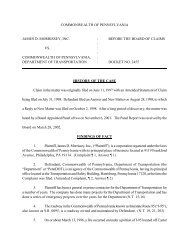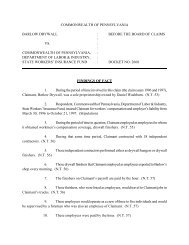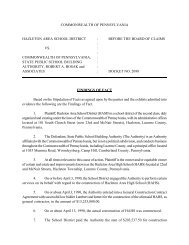3720 - Board of Claims
3720 - Board of Claims
3720 - Board of Claims
Create successful ePaper yourself
Turn your PDF publications into a flip-book with our unique Google optimized e-Paper software.
21. By prescribing the character, dimensions, location and other design specifications<br />
for reconstruction and paving <strong>of</strong> the Project roadway, PennDOT provided design specifications for<br />
these tasks and warranted to Intercounty that these plans and specifications would be adequate to<br />
construct the Project. United States v. Spearin, 248 U.S. at 137, 39 S. Ct. at 61; Canuso v. City <strong>of</strong><br />
Philadelphia, 192 A. at 136; A.G. Cullen Construction, 898 A.2d at 1160; W.P. Dickerson & Son,<br />
400 A.2d at 932; Allentown Supply Corp. v. Stryer, 195 A.2d at 279.<br />
22. Delays and damages incurred in construction occasioned by the necessity <strong>of</strong> altering<br />
plans because <strong>of</strong> an owner’s failure to originally provide adequate design are properly charged to<br />
the owner. C.J. Langenfelder & Son, Inc. v. Department <strong>of</strong> Transportation, 404 A.2d 745 (Pa.<br />
Cmwlth. 1979).<br />
23. PennDOT also had the responsibility for securing all necessary rights-<strong>of</strong>-way for<br />
the Project in advance <strong>of</strong> construction. 408 Specifications, § 107.18; Sheehan v. City <strong>of</strong><br />
Pittsburgh, 62 A. 642 (Pa. 1905).<br />
24. Intercounty established by substantial evidence that PennDOT did not properly plan<br />
for sufficient rights-<strong>of</strong>-way to accommodate the guy wires at several new pole locations. DGS v.<br />
Pittsburgh Building Co., 902 A.2d at 989.<br />
25. Because PennDOT failed to provide Project plans and design adequate to construct<br />
the Project (by prescribing the location <strong>of</strong> the new utility poles through its permitting process for<br />
this Project and then prescribing the character, dimensions, location and other design specifications<br />
for reconstruction and paving <strong>of</strong> the Project roadway, but failing to provide sufficient room within<br />
its rights-<strong>of</strong>-way for guy wires (as needed) on these new poles in its plans and design), PennDOT<br />
materially breached the Contract and actively interfered with Intercounty’s work on the Project.<br />
United States v. Spearin, 248 U.S. at 137, 39 S. Ct. at 61; Canuso v. City <strong>of</strong> Philadelphia, 192 A. at<br />
136; A.G. Cullen Construction, 898 A.2d at 1160; W.P. Dickerson & Son, 400 A.2d at 932;<br />
Allentown Supply Corp. v. Stryer, 195 A.2d at 279.<br />
26. Because PennDOT failed to adequately coordinate the utility pole and wire<br />
relocation for the Project during the pre-Contract design phase, and thereby failed to act in a matter<br />
necessary for prosecution <strong>of</strong> work on the Project (by, inter alia: prescribing the location <strong>of</strong> the new<br />
utility poles through its permitting process for this Project and then prescribing the character,<br />
dimensions, location and other design specifications for reconstruction and paving <strong>of</strong> the Project<br />
roadway, but failing to provide sufficient room within its rights-<strong>of</strong>-way for guy wires (as needed)<br />
on these new poles in its plans and design; failing to provide the utility companies affected by the<br />
Project with the Construction Sequence and the final plans for the Project sufficiently in advance<br />
<strong>of</strong> the start <strong>of</strong> actual work on the Project site so these utility companies could effectively plan<br />
ahead for the timing and sequencing <strong>of</strong> the pole relocation work prescribed by the Contract; and<br />
failing to indicate the old utility poles to be removed and/or the location <strong>of</strong> the new utility poles to<br />
be installed on these final plans and drawings), PennDOT materially breached the Contract and<br />
actively interfered with Intercounty’s work. See e.g., Coatesville Contractors, 506 A.2d at 865-<br />
867; General Asphalt Paving, 405 A.2d at 1140-1141; Gasparini, 187 A.2d 161-162; S.J Groves &<br />
Sons, Co., 343 A.2d at 76; Sheehan v. Pittsburgh, 62 A. at 642; Pittsburgh Building Co., 920 A.2d<br />
at 987.<br />
49






